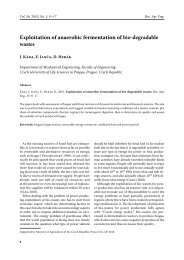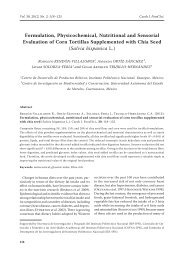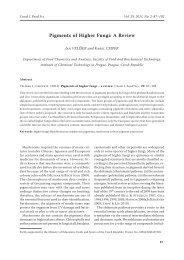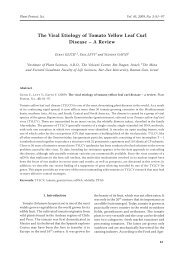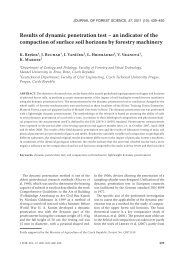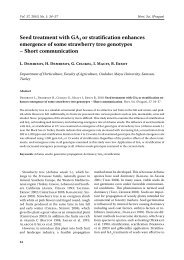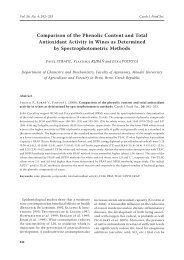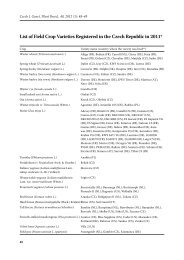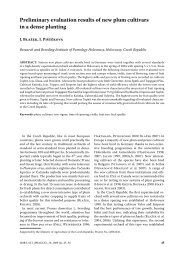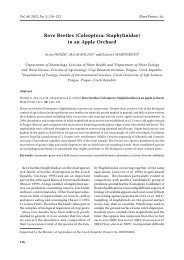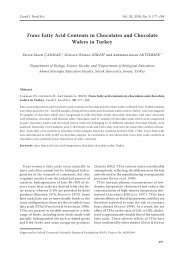Efficacy loss of strobilurins used in protection against apple scab in ...
Efficacy loss of strobilurins used in protection against apple scab in ...
Efficacy loss of strobilurins used in protection against apple scab in ...
Create successful ePaper yourself
Turn your PDF publications into a flip-book with our unique Google optimized e-Paper software.
Hort. Sci. (Prague) Vol. 40, 2013, No. 2: 45–51<br />
Relative Mycelial Growth (RMG) was calculated.<br />
RMG = % <strong>of</strong> mycelial growth <strong>in</strong> KM × 100/% <strong>of</strong> mycelial<br />
growth on plates without KM.<br />
DNA extraction and amplification <strong>of</strong> target<br />
genes’ regions. DNA was extracted from fungal mycelium<br />
by GenElute Plant M<strong>in</strong>i Kit (Sigma Aldrich,<br />
Seelze, Germany). Up to 100 mg <strong>of</strong> mycelium was<br />
homogenised <strong>in</strong> liquid nitrogene (LN) <strong>in</strong> 2 ml polypropylene<br />
tube by glass stick. The LN was added directly<br />
<strong>in</strong>to tube for optimal disruptions <strong>of</strong> mycelium.<br />
The homogenate was extracted us<strong>in</strong>g standard plant<br />
m<strong>in</strong>iprep protocol with two-times prolonged step <strong>of</strong><br />
the lysis. DNA was eluted <strong>in</strong>to two 75 ml portions<br />
<strong>of</strong> TE buffer. Quality <strong>of</strong> DNA sample was evaluated<br />
by NanoPhotometer (Implen, München, Germany).<br />
Primer pairs flank<strong>in</strong>g key parts <strong>of</strong> target genes<br />
were designed by means <strong>of</strong> NCBI Primer-BLAST<br />
(Ye et al. 2012) us<strong>in</strong>g sequences <strong>of</strong> cytb gene (NCBI<br />
entry AF004559 by Zheng et al. 1997) and betatub<br />
gene (NCBI entry M97951 by Koenraadt et<br />
al. 1992). Information about primers are summarised<br />
<strong>in</strong> Table 1. Polymerase cha<strong>in</strong> reaction (PCR)<br />
mixture (25 ml) conta<strong>in</strong>ed 40 ng <strong>of</strong> DNA, 1× Taq +<br />
KCl PCR reaction buffer (Fermentas, Vilnius, Lithuania),<br />
MgCl 2<br />
(2.5 nmol/ml), equimolar mixture <strong>of</strong><br />
dNTP (0.25 nmol/ml), primer pair (0.3 nmol/ml)<br />
and 0.5 unit <strong>of</strong> Taq DNA polymerase (Fermentas).<br />
Amplification conditions were optimised as follows:<br />
1× 95°C 3 m<strong>in</strong> followed by 35 cycles consisted from<br />
denaturation (95°C, 30 s), anneal<strong>in</strong>g (58°C, 30 s) and<br />
extension (72°C, 60 s). Amplification was f<strong>in</strong>ished by<br />
f<strong>in</strong>al extension (72°C, 5 m<strong>in</strong>).<br />
Detection <strong>of</strong> cytb-G143A and beta-tub E198A<br />
mutations. The method detect<strong>in</strong>g ssDNA conformation<br />
polymorphism (SSCP) performed <strong>in</strong> DCodeTM<br />
(Bio-Rad, Hercules, USA) was <strong>used</strong> for detection<br />
G143A. Conditions for SSCP analysis were as follows.<br />
The 16 × 16 cm gel consisted <strong>of</strong> 8% acrylamidebisacrylamide<br />
mixture (37.5:1), 0.5× TBE buffer and<br />
10% <strong>of</strong> glycer<strong>in</strong>e. 10 ml <strong>of</strong> PCR products were mixed<br />
with 10 ml SSCP Load<strong>in</strong>g Dye (Bio-Rad), denaturised<br />
for 10 m<strong>in</strong> at 94°C and immediately moved on<br />
the ice. After 20 m<strong>in</strong> <strong>of</strong> cool<strong>in</strong>g the samples were<br />
loaded on the gels and separated for 3 hours. Power<br />
supply was set on 30 W. Initial temperature <strong>of</strong> separation<br />
system was 5°C and after start <strong>of</strong> separation the<br />
temperature was stabilised by ice bath at 10°C. After<br />
the separation, gels were sta<strong>in</strong>ed by ethidiumbromide<br />
for 15 m<strong>in</strong> and then visualised and documented by<br />
GelDocXR (Bio-Rad). Sta<strong>in</strong><strong>in</strong>g bath consisted <strong>of</strong> 0.5 l<br />
<strong>of</strong> electrophoretic buffer supplemented by 0.8 mg <strong>of</strong><br />
ethidiumbromide.<br />
T6II amplicons were analysed by BstUI restrictase<br />
(Fermentas) with respect to manufacturer’s recommendation.<br />
Polymorphisms were detected by electrophoresis<br />
<strong>in</strong> 2% agarose gel sta<strong>in</strong>ed by ethidiumbromide<br />
(0.5 mg/ml).<br />
RESULTS AND DISCUSSION<br />
Spores germ<strong>in</strong>ation and mycelial growth<br />
under kresoxim-methyl<br />
Set <strong>of</strong> 78 isolates was evaluated by conidia germ<strong>in</strong>ation<br />
test. Mycelial growth was evaluated for<br />
54 isolates. Results showed high rate <strong>of</strong> KM resistance<br />
(Table 2) <strong>in</strong> evaluated isolates. The control isolate<br />
Lázně Bělohrad obta<strong>in</strong>ed from the solitary tree<br />
never treated by fungicides demonstrated RCG = 0<br />
whilst isolates from orchards periodically treated<br />
by <strong>strobilur<strong>in</strong>s</strong> were highly resistant (RCG varied<br />
from 30 to 96%). Already 15% RCG demonstrates<br />
high risk for economically significant disease development.<br />
Similar situation was observed <strong>in</strong> tests <strong>of</strong><br />
relative mycelial growth (RMG). In isolates Choustníkovo<br />
Hradiště, Kamenice (cv. Golden Delicious)<br />
and Břasy RMG equal to 100% was observed. The<br />
test is well <strong>in</strong>formative <strong>in</strong> actual status <strong>of</strong> resistance<br />
<strong>in</strong> orchard and can be good tool to verify <strong>of</strong> resistance<br />
<strong>in</strong> cases when the chemical <strong>protection</strong> failed.<br />
But there was also repeatedly observed low value <strong>of</strong><br />
RCG <strong>of</strong> isolate Rohozec (cv. Šampion) <strong>in</strong> relation to<br />
presence <strong>of</strong> G143A. This discrepancy can be partially<br />
expla<strong>in</strong>ed by f<strong>in</strong>d<strong>in</strong>g <strong>of</strong> Zheng et al. (2000). They<br />
studied mutation ratio <strong>of</strong> the cytb gene <strong>in</strong> laboratory<br />
conditions and results <strong>in</strong>dicated very low value <strong>of</strong><br />
this parameter (about 4.4 × 10 –8 ). If the mutation ratio<br />
<strong>in</strong> natural conditions is similar, molecular analysis<br />
can detect hidden mutation <strong>in</strong> isolate and very<br />
low RCG is then observed due to low abundance<br />
<strong>of</strong> mutated spores <strong>in</strong> the sample. It is possible believe<br />
that the test <strong>of</strong> conidia germ<strong>in</strong>ation is not fully<br />
sufficient to monitor<strong>in</strong>g <strong>of</strong> resistant populations <strong>in</strong><br />
orchards and it should be supported by direct molecular<br />
screen<strong>in</strong>g <strong>of</strong> population. This presumption<br />
corresponds to results <strong>of</strong> Fonta<strong>in</strong>e et al. (2008).<br />
Molecular detection <strong>of</strong> cytb<br />
and beta-tub mutations<br />
Primers VB4 amplified fragment 158 bp <strong>in</strong>clud<strong>in</strong>g<br />
the exon 4 <strong>of</strong> cytb <strong>in</strong> accordance with expected<br />
47



